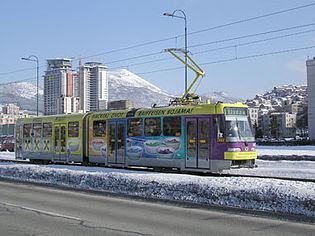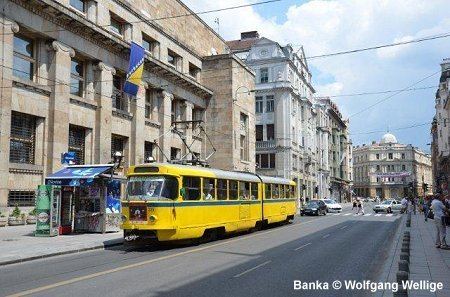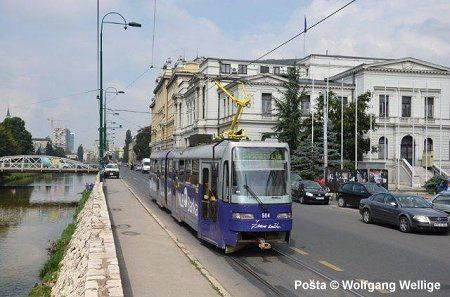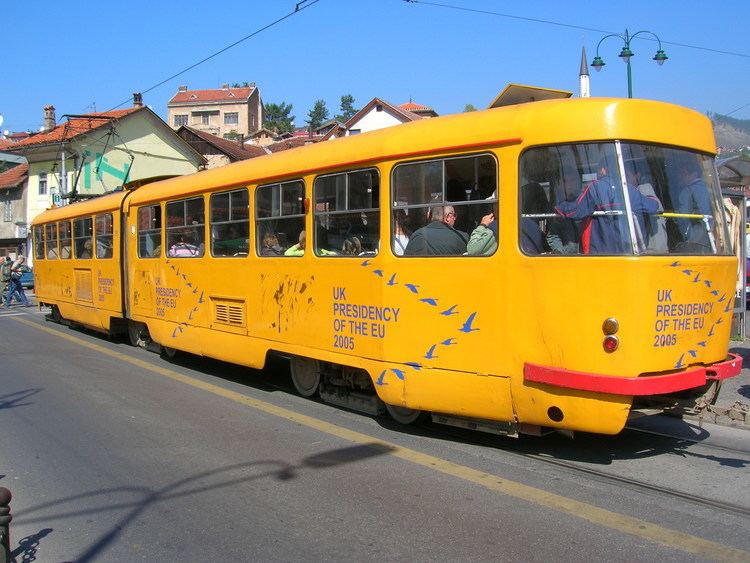Website www.gras.ba Minimum radius of curvature (?) Number of lines 6 | System length 22.9 km (14.2 mi) Locale Sarajevo Number of vehicles 95 Number of stations 28 | |
 | ||
Track gauge 1,435 mm (4 ft 8 ⁄2 in) standard gauge Old gauge 760 mm (2 ft 5 ⁄16 in) Bosnian gauge until 1960 Began operation : 1885 (horse tram); 1895 (electric tram); | ||
The Sarajevo tram network is one of Europe's oldest, having originally served as the test line for Vienna's trams. As of 2010, the Sarajevo tram system consists of seven lines, primarily running along a single track route. The system is 22.9 kilometres (14.2 mi) long; this includes a 0.4 kilometres (0.25 mi)-long branch to the city's railway station (Željeznička Stanica). It primarily serves as an east-west link from the city centre district (Baščaršija) to the suburb Ilidža.
Contents

The system is run by KJKP GRAS Sarajevo, who also operate trolleybus and bus routes in the city.
History

Opened on New Years Day in 1885, the Sarajevo tramway was the testing line for the tram in Vienna and the Austro-Hungarian Empire, and operated by horses. Originally built to 760 mm (2 ft 5 15⁄16 in) Bosnian gauge, the present system was upgraded to 1,435 mm (4 ft 8 1⁄2 in) standard gauge in 1960. The trams played a pivotal role in the growth of the city in the 20th century.

During the Siege of Sarajevo in the mid 1990s, trackwork and numerous vehicles were badly damaged - these are once again operational though marks remain on some vehicles.
System

The route lies on the main boulevard of Sarajevo, which is named (from west to east) first Bulevar Meše Selimovića (formerly 6 Proleterske Brigade), from Vila Čengić then Zmaj od Bosne (formerly Vojvode Radomira Putnika). From the district Marijin Dvor it runs a loop in a counter-clockwise direction along the Miljacka river on the street called Obala Kulina bana (formerly: Obala Vojvode Stepe Stepanovića). It proceeds to the terminus Baščaršija. The route then turns back towards Marijin Dvor on the northern parallel road Maršala Tita.

Six routes are presently in operation on the system, often only a specific section of the track. Only route 3 operates the entire length.

Rolling stock
In 1958, Sarajevo bought 50 relatively modern PCC-cars from Washington, renumbered in the 1-50 series. 21 more PCC-cars from Washington followed in 1962, numbered 51-71. These 71 PCC-cars were built between 1941 and 1944 by the St. Louis Car Company. Between 1967 and 1969, 20 of these streetcars were transformed into 10 articulated cars series 100-109.
The fleet in use on the network are Tatra K2 articulated trams from the Czech Republic, delivered in the 1970s and early 1980s. Later these trams have been joined by more modern vehicles in recent times. In 2008, Amsterdam donated 16 old trams to Sarajevo.
